
Dong Van is a district encompassing two towns, Dong Van and Pho Bang, along with 17 communes. It is about 320 kilometers away from Hanoi. This northernmost area of Vietnam, which shares a 52.5-km border with China, often serves as a stopover for those journeying to Ha Giang City. Here, the essence of local culture and natural beauty converge. Dong Van's landscape is complex, with rocky mountains sculpting deep valleys and an average elevation of 1,500 meters above sea level.
Dong Van is immersed in a monsoon climate imbued with continental characteristics. The region receives a considerable average annual rainfall of 1,750 to 2,000 millimeters, concentrated mainly from May to October. The dry season spans from November to April.
Annual temperatures hover around 20 degrees Celsius, occasionally dipping to 1-2 degrees Celsius during the coldest months, and reaching nearly 40 degrees Celsius at their peak. Humidity envelops the air at around 84%. Winter might even bring frost and the occasional snowfall to the region.
Dong Van Plateau is stunning throughout the year, with each season having its own charm. Here's an overview of the best times to visit:
- January-February: Enjoy peach and plum blossoms, and yellow brassica napus flowers swaying in the mist.
- March-April: See highland red bombax ceiba flowers blooming brightly.
- April-May: Experience terraced rice fields with flowing water.
- September-October: View ripe golden rice fields.
- October-December: Admire the bloom of buckwheat flowers.
Dong Van Old Town
Located at the heart of the Dong Van Karst Plateau Global Geopark, Dong Van Old Town is an unmissable gem. This town emerged over a century ago from what was once a wild valley. When viewed from above, Dong Van Old Town forms a U-shaped arrangement of houses with yin and yang tiled roofs. This includes houses and small-scale businesses, all showcasing characteristics that reflect the identity of the rocky plateau.
One should not overlook the opportunity to savor Pho Co Cafe at the corner of Dong Van
central market. It's located in a hundred-year-old mountain-leaning house.
Tham Ma Slope

Tham Ma Slope is graced with lush greenery on either side. Photo courtesy of Dulich24
Tham Ma Slope is a rugged part of National Highway 4C, neighboring Yen Minh and Dong Van districts. This road is renowned for being one of the most perilous in the North, spanning 5 kilometers with 9 winding turns. A visit promises breathtaking views and the chance to immerse yourself in local legends.
Vuong Mansion
The Vuong Mansion in Sa Phin Commune, built in the early 20th century, replicates Qing Dynasty (China) architecture. It took 8 years to construct the mansion, which graces 1,120 meters of land.
The mansion resembles a tortoise shell, surrounded by tall agarwood trees. It features two stone walls with battements and guardhouses.
The palace encompasses three stilted houses: the main house faces the gate, while two outbuildings run parallel and perpendicular to it. All
three structures, from columns to roofs, are crafted from precious wood.
Vuong Mansion rests next to Highway 4C on the route from Ha Giang City to Dong Van, 13 kilometers from the center of Dong Van Town. In 1993, Vuong Mansion was recognized as a national architectural and artistic relic by the Ministry of Culture, Sports and Tourism.
Nho Que River
The Nho Que River originates in Yunnan Province, China, flows northwest to southeast through Dong Van and Meo Vac districts in Ha Giang Province, and joins the Gam River in Cao Bang Province. The river stretches for 46 kilometers within Vietnam, passing Lung Cu Commune and Tu San Canyon, and then following the Ma Pi Leng Pass.
The river's water is turquoise for most of the year.
Local tour companies offer boat rides and kayaking for visitors, with rental prices ranging from VND50,000 to VND150,000 ($2.10 to $6.25) per boat, depending on the type.
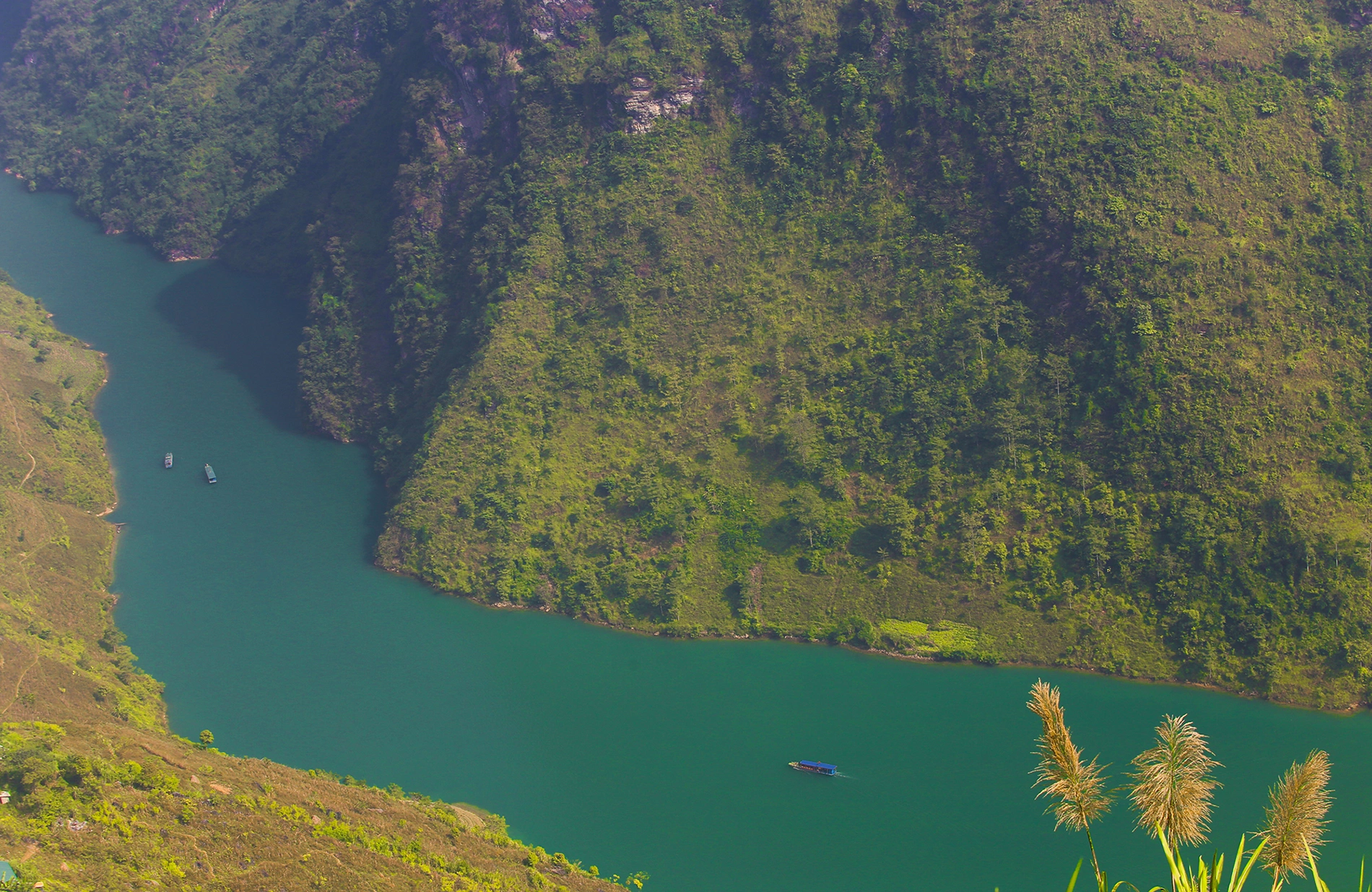
Viewed from above, a segment of the Nho Que River stands out due to its rich turquoise color. Photo by VnExpress/Xuan Phuong
To access the wharf, visitors need to go through a zigzag path. It's advisable to hire a local guide familiar with the route to ensure a safe journey.
Lung Cu Flag Tower
Lung Cu Flag Tower stands on Lung Cu Peak, at 1,470 meters above sea level in Lung Cu Commune. It's approximately 3.3 kilometers from Vietnam's northernmost point, and is 24 kilometers from Dong Van Town.
With a rich history, the flagpole has seen numerous renovations and enhancements. Presently, it stands over 30 meters tall with an octagonal shape and was inaugurated on September 25, 2010. At its pinnacle, a 9-meter high flagpole carries the Vietnamese national flag over an area of 54 meters square. From the top, one can see two perennial ponds on either side of the mountain, often referred to as the "dragon's eye" ponds.
Sung La buckwheat flower field
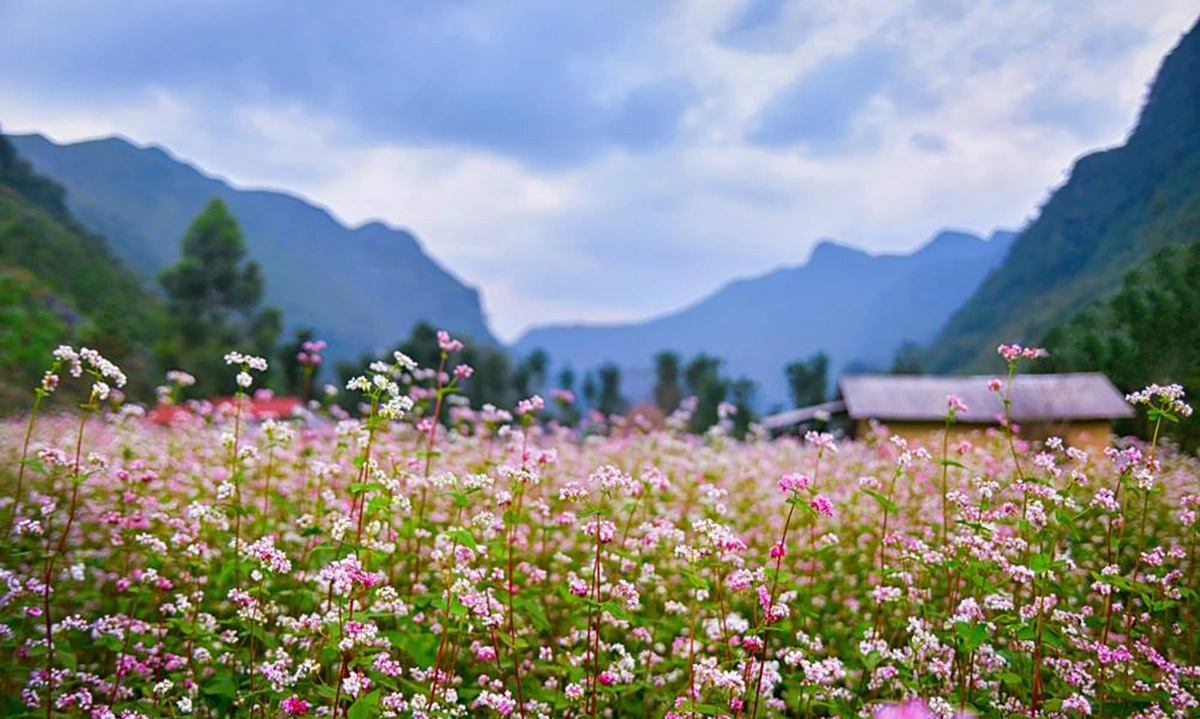
When in bloom, the Sung La buckwheat flower field is adorned with light pink blossoms. Photo by VnExpress/Cao Anh Tuan
About 20 kilometers from Dong Van Town, Sung La Commune features a buckwheat flower field beneath rock cliffs. The local Hmong community cultivates buckwheat on steep hillsides, making this spot one of Ha Giang's most stunning flower-viewing areas. The prime time to visit is from October to November.
Pao’s House
Pao's House, situated in Sung La Commune, was constructed in 1947. It served as the backdrop for the film "Pao's Story." The house showcases the architectural style of the local Hmong community in the rocky highlands, encompassed on all sides with a central courtyard. The front yard is adorned with stone paving and bordered by the region's signature trees such as plums, apricots, and peaches. Visiting this spot incurs a fee of VND10,000 (40 cents) per tourist.
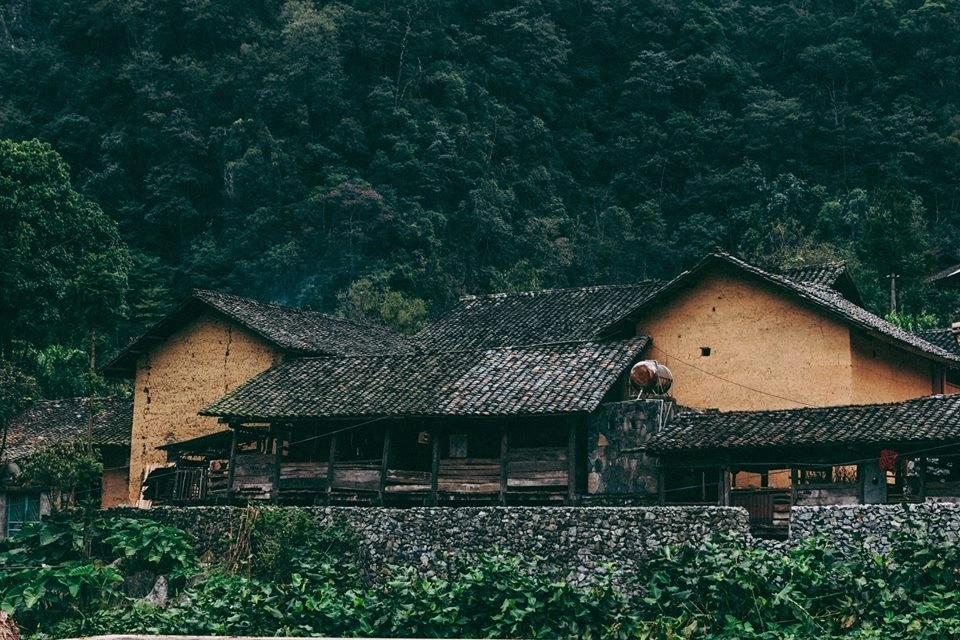
Pho Bang Town
Compared to busier locations, Pho Bang Town offers a sense of unhurried time. Home to over 500 Chinese and Hmong residents, the town is recognized for its tranquil and ancient ambiance. Pho Bang is positioned close to the Vietnam-China border and is located about 5 kilometers away from the national highway.
Pho Cao ethnic market
Pho Cao ethnic market is situated 25 kilometers from Dong Van Town and is open every 6 days, typically from dawn until noon. It serves as both a marketplace for buying and selling goods, including local products, and a hub for cultural interactions among the region's 17 ethnic groups. The market bustles with activity, as people showcase their finest attire and offer a diverse range of items such as livestock, clothing, knives, and freshly harvested garden vegetables.
Au tau porridge
Au tau (Aconitum Fortunei
Hemsl) porridge is a Ha Giang specialty made from ingredients like au tau tubers, rice, pork, pork rolls, eggs, vegetables, and more.
Au tau tubers are commonly found in the highlands of Ha Giang. Despite being initially toxic, local processing turns them into a delicious
dish.
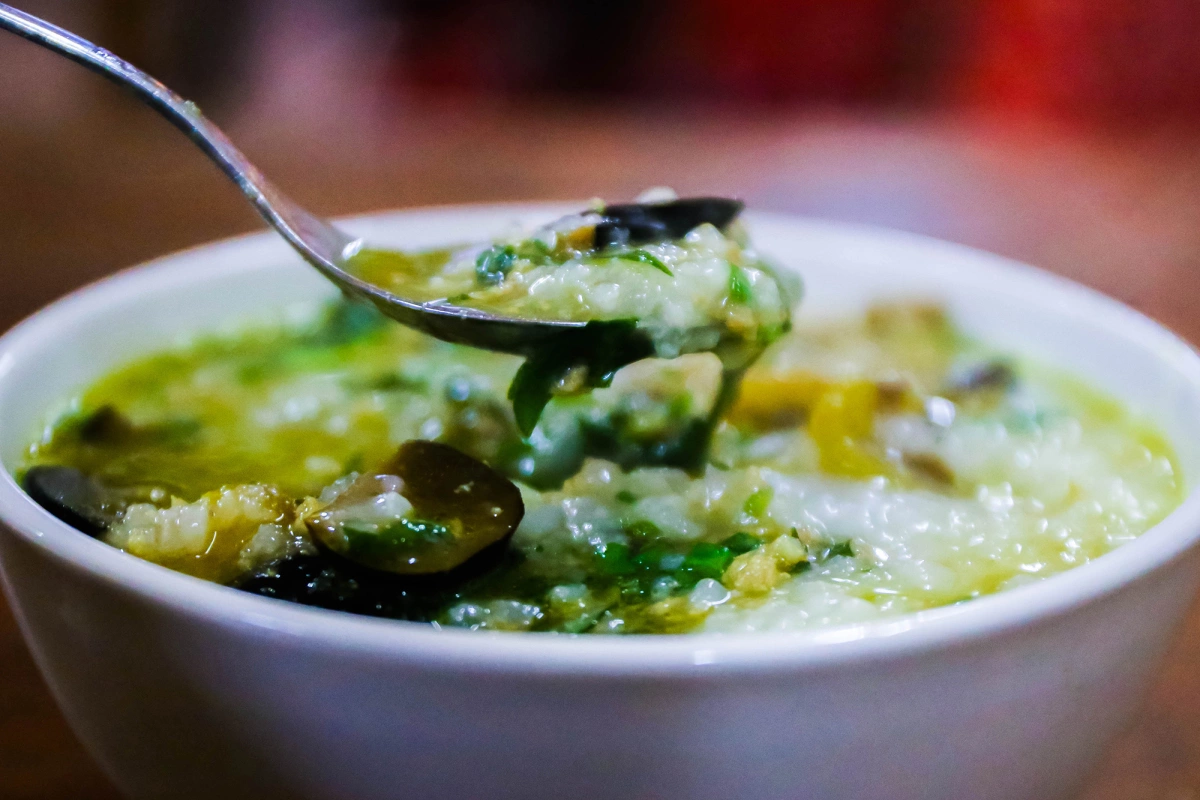
A bowl of au tau porridge is garnished with coriander and perilla. Photo by VnExpress/Xuan Phuong
Au tau also holds medicinal value, aiding in relieving colds, muscle relaxation, fatigue reduction, and promoting better sleep. To prepare the porridge, tubers are soaked in rice water for around 10 hours, then simmered for extended periods until they soften and lose their toxicity.
Visitors can find au tau porridge at Moc Mien porridge shop in Dong Van Market.
Rice rolls
This dish includes rice flour, meat, wood ear mushroom, pork bones, pork rolls, and spices. The rice flour is soaked overnight and mixed with spices. When ordered, the batter is poured onto a heated mold on the spot. After around 3 minutes, the rice rolls are cooked, filled with meat and stir-fried wood ear mushroom, cut into smaller pieces, placed on a plate, and topped with fried shallots and coriander.
Unlike rice rolls in many regions, Ha Giang rolls are eaten with broth. The broth is made from simmering pork bones, resulting in a sweet and savory flavor. Locals mention that due to the cold mountain mornings, people consume rice rolls with broth to warm themselves.
Visitors can enjoy rice rolls at Ms. Ha's eatery on 31 Old Town Street, Ha Giang City, or at Ms. Lieu's eatery on 3/2/No. 22 National Highway 4C, Dong Van District, Ha Giang City.
Buckwheat cake
Buckwheat cake is crafted from buckwheat flower seeds. After harvesting, the seeds are dried and some are used for yeast while the rest make
the cakes. The ground seeds are kneaded into round cakes, larger than a hand's size. These cakes are then steamed and charcoal-baked, ideally
enjoyed warm with a gentle sweetness.
Visitors can find these cakes in markets, roadside stalls, and close to tourist spots.
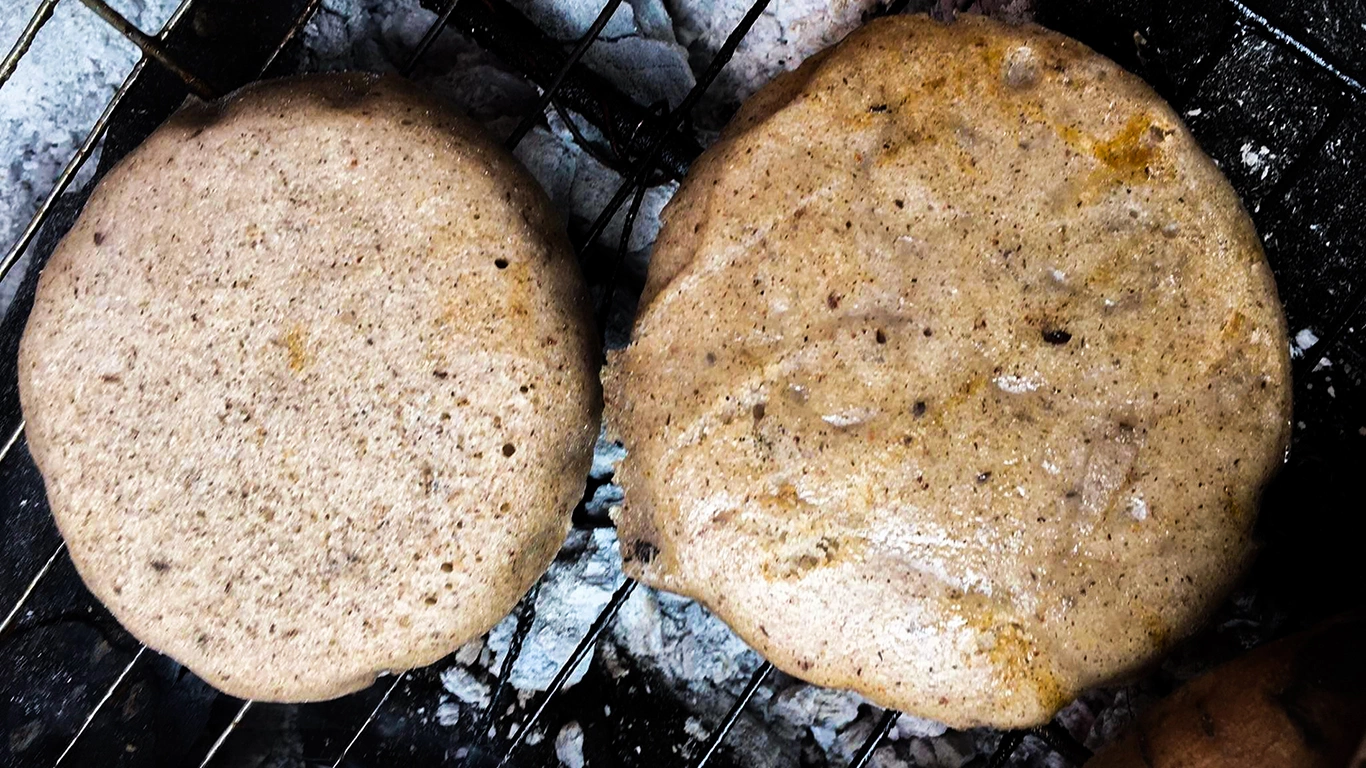
Thang den (boiled glutinous rice dumplings)
Thang den, widely available in Dong Van Old Town and markets, might be considered a snack, yet they hold a unique charm. These bowls feature boiled round glutinous rice balls in ginger-infused sugar water, heightened by the addition of black sesame or crushed roasted peanuts.
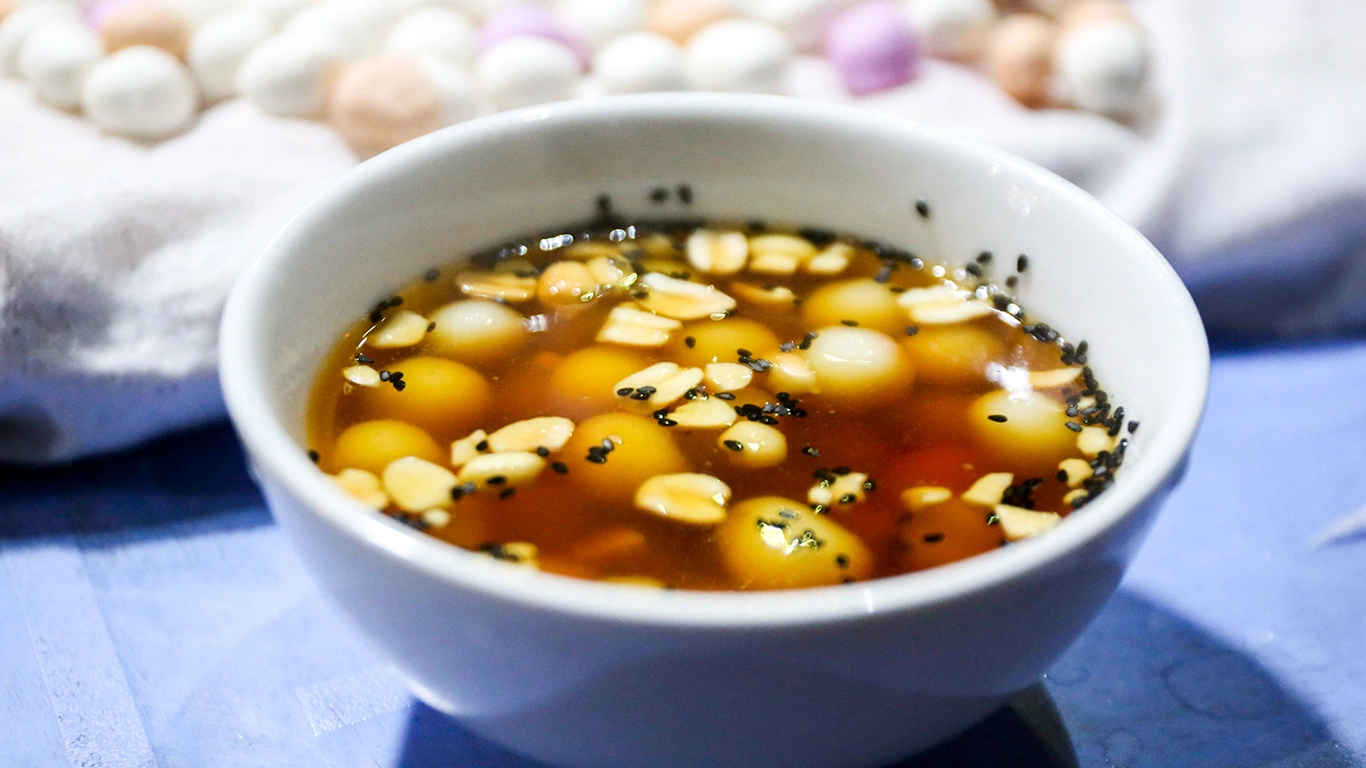
A bowl of thang den captures diners' attention with its vibrant ginger-colored sugar water and colorful glutinous rice balls. Photo by VnExpress/Xuan Phuong
Men men (steamed minced corn)
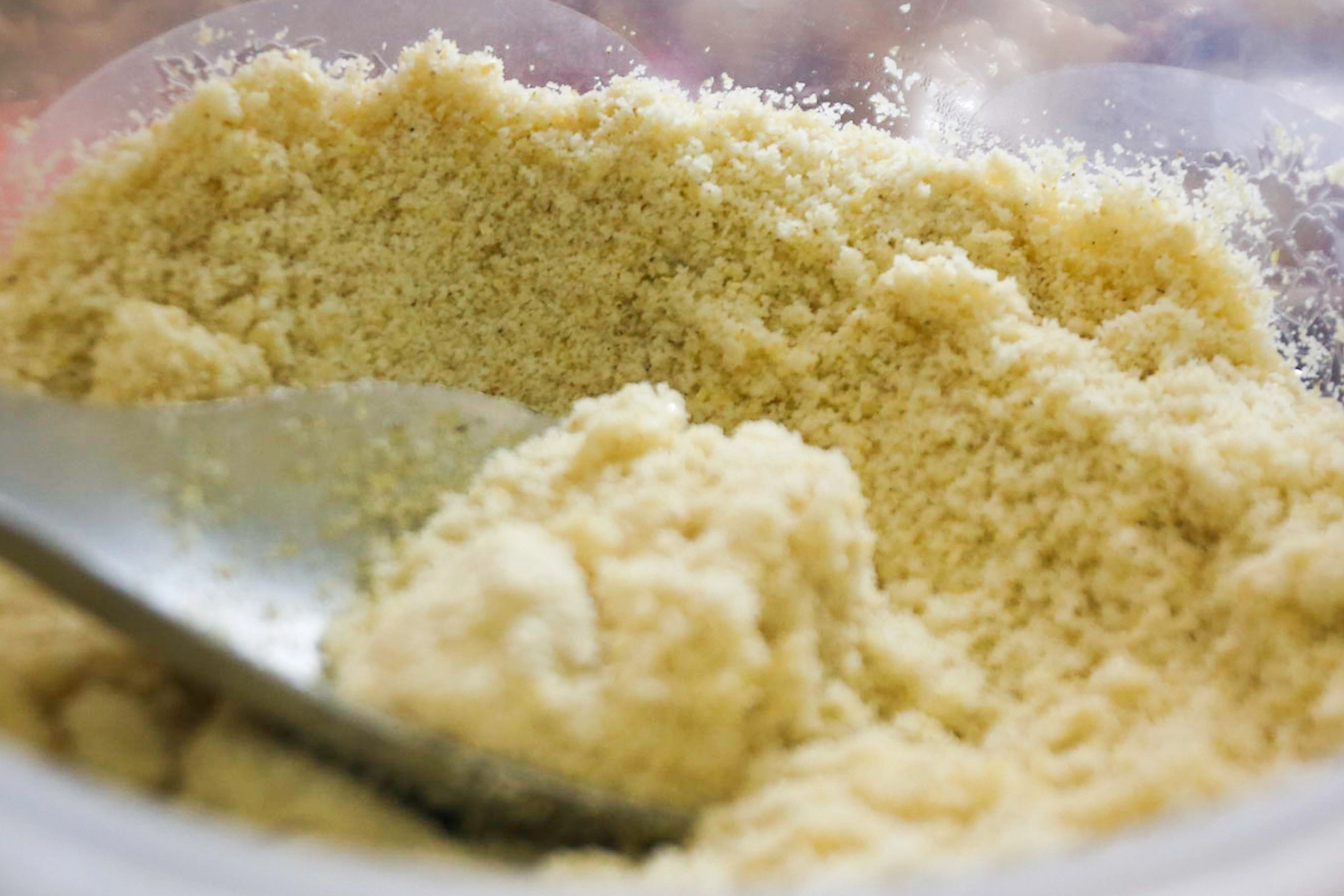
Men men features finely ground corn that is steamed, resulting in a vivid yellow hue. Photo by VnExpress/Xuan Phuong
Given the rocky terrain, rice cultivation is limited, but men men is still a staple among the Hmong people. Originally a homemade meal, men men gradually found its way into various markets. To prepare the dish, corn undergoes several steps including drying, pounding, and steaming. The resulting dish carries a distinct corn aroma and can be enjoyed with added broth.
The North Pole Cafe
The North Pole Cafe stands in Lo Lo Chai village, nestled at the base of the Lung Cu flagpole. It's situated less than 1 kilometer from the Vietnam - China border in Lung Cu Commune. Constructed by Ogura Yasushy, a devoted Japanese resident of Vietnam, the cafe reflects his deep affection for Ha Giang.
With its traditional house design, the cafe echoes the Lo Lo cultural heritage, boasting stone walls, yin and yang tiled roofs, earthy walls, and wooden gates. The cafe offers both traditional Vietnamese filter coffee and Japanese matcha green tea.
In Dong Van, visitors can find various accommodation options including guesthouses, homestays, and larger hotels. There are many homestays located throughout the town and its communes, including Homestay Hagiang Holic, Plum Homestay, and more. Prices for homestays range from VND400,000 to VND1 million ($16.70 to $42) per room, or VND100,000 to VND250,000 for a mattress in a dorm or stilt house.
Hotels like Hoa Cuong Hotel, Hoang Van, Hoang Ngoc, and Ma Pi Leng Hotel offer rooms at an average price of VND400,000 to VND1 million per night.
Dong Van is 150 kilometers north of Ha Giang City, reachable via Highway 4C. Travelers have many options, like motorcycles, cars, and buses. The journey usually takes 3 to 5 hours, depending on your chosen mode of travel.
In Dong Van town, travelers have the opportunity to rent motorbikes for approximately VND100,000 ($4) per day.
Story by Tam Anh